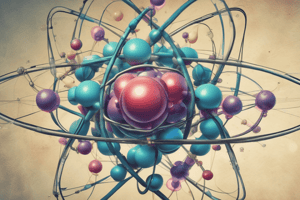Podcast
Questions and Answers
What is the atomic number defined as?
What is the atomic number defined as?
- The sum of protons and neutrons in the nucleus
- The number of protons in the nucleus (correct)
- The number of electrons orbiting around the nucleus
- The total number of electrons and protons combined in the atom
How is an isotope different from a regular atom of an element?
How is an isotope different from a regular atom of an element?
- It has a different number of protons
- It has a different number of electrons
- It has a different mass number (correct)
- It has a different atomic number
Which subatomic particles are located in the nucleus of an atom?
Which subatomic particles are located in the nucleus of an atom?
- Only protons
- Protons and neutrons (correct)
- Protons and electrons
- Electrons and neutrons
How do atoms of the same element differ from each other?
How do atoms of the same element differ from each other?
What determines the atomic mass number of an atom?
What determines the atomic mass number of an atom?
How do unstable elements that don't occur naturally need to be produced?
How do unstable elements that don't occur naturally need to be produced?
Which statement accurately describes the electron dot configuration?
Which statement accurately describes the electron dot configuration?
What information does the atomic number provide about an element?
What information does the atomic number provide about an element?
Flashcards are hidden until you start studying
Study Notes
Atomic Structure
An atom consists of a central, positively charged nucleus surrounded by a cloud of negatively charged electrons orbiting around it. The nucleus itself houses protons and sometimes neutrons. Hydrogen atoms are exceptional as they contain just one proton; all other atoms have multiple protons in the nucleus, giving them an atomic number, which is how you identify different elements.
Each element is characterized by having the same number of protons, meaning it shares the same atomic number. For instance, carbon always has six protons, regardless if it appears in coal, diamonds, or graphite. Atoms of the same element can have varying numbers of neutrons, creating what we call isotopes. For example, hydrogen has three isotopes: regular hydrogen, deuterium, and tritium. There are currently 118 known elements, although only those with atomic numbers between 1 and 98 occur naturally in the world. The rest must be synthesized in laboratories due to their inherent instability.
Every atom also possesses an atomic mass number (A) and a mass number (m). The mass number equals the sum of the protons and neutrons in the nucleus, while the atomic mass number represents the weighted average mass of the atom, taking into account the naturally occurring isotopic mix. Atoms of the same element can differ in mass due to variations in the number of neutrons present among their isotopes. Approximately 253 stable isotopes exist, along with more than 3000 radioactive ones.
When speaking specifically about the periodic table, we refer to these forms as nuclides, and we label them with both the name of the element and the mass number of the atom when discussing specific compounds like lithium-7 or uranium-238.
Studying That Suits You
Use AI to generate personalized quizzes and flashcards to suit your learning preferences.




